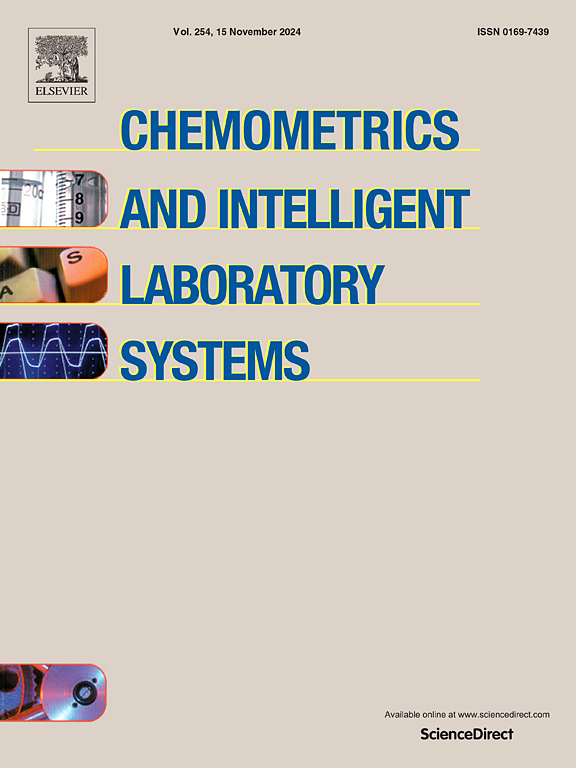DD-SIMCA作为评估候选海洋沉积物参考物质短期稳定性的替代工具
IF 3.7
2区 化学
Q2 AUTOMATION & CONTROL SYSTEMS
Chemometrics and Intelligent Laboratory Systems
Pub Date : 2024-12-22
DOI:10.1016/j.chemolab.2024.105312
引用次数: 0
摘要
稳定性测试在标准物质(RM)的生产中是必不可少的。它们可以分为短期(运输条件)和长期(货架时间)。稳定性试验的评价使用回归方法进行,如ISO指南35所示。然而,一些研究强调使用多元方法评价在原料生产中进行的试验。因此,这项工作提出了数据驱动的软独立建模类类比(DD-SIMCA)方法,作为评估候选参考材料短期稳定性测试数据的可行替代方案,用于用海洋沉积物基质测定金属。在60°C的温度下进行了一个月的等时测试。样品采用EPA 3051 A法分解(一式三份),采用电感耦合等离子体质谱法(ICP- ms)和电感耦合等离子体发射光谱法(ICP OES)进行分析。标准温度(- 20°C)下的样品质量分数为(mg kg - 1): Ba为70.4±4.5,Co为12.0±0.7,Cu为17.9±1.0,Zn为60.7±3.3,Al为49137±4790,Fe为60021±3090。与实验条件(60°C)下4周样品的质量分数(mg kg-1)比较,Ba为70.0±4.0,Co为12.1±0.5,Cu为17.4±0.8,Zn为60.6±2.9,Al为48388±3424,Fe为58049±1886。用回归法对标准品质量分数与试验条件进行了比较。DD-SIMCA方法中应用的模型使用两个主成分(alpha值和置信区间为0.05)和保存在- 20°C的样品的仪器五倍数构建。60℃下的样品与所构建的模型拟合,表明这些样品的性能与保持在参考温度下的样品没有显著差异。通过回归方法和DD-SIMCA方法,认为RM候选物在60°C温度下稳定一个月。多元方法DD-SIMCA被认为是评估RM生产过程中实现的短期稳定性测试结果的可能替代和验证工具。本文章由计算机程序翻译,如有差异,请以英文原文为准。
DD-SIMCA as an alternative tool to assess the short-term stability of a marine sediment reference material candidate
The stability test is essential in the production of a reference material (RM). They can be classified as short-term (transport conditions) and long-term (shelf time). The evaluation of the stability test is carried out using the regression method, as indicated by ISO Guide 35. However, some studies have highlighted the use of multivariate methods in the evaluation of tests performed in RM production. Therefore, this work presents the data driven soft independent modeling class analogy (DD-SIMCA) method as a viable alternative for evaluating data from the short-term stability test of a candidate reference material for metal determination with marine sediment matrix. The test was performed isochronously for one month at a temperature of 60 °C. The samples were decomposed (in triplicate) by the EPA 3051 A method and analyzed by inductively coupled plasma mass spectrometry (ICP-MS) and inductively coupled plasma optical emission spectrometry (ICP OES). Samples mass fractions stored at standard temperature (−20 °C) were (mg kg−1): 70.4 ± 4.5 for Ba, 12.0 ± 0.7 for Co, 17.9 ± 1.0 for Cu, 60.7 ± 3.3 for Zn, 49137 ± 4790 for Al, and 60021 ± 3090 for Fe. These values were compared with the mass fractions of samples subjected to the test condition (60 °C) for four weeks, which were (mg kg-1): 70.0 ± 4.0 for Ba, 12.1 ± 0.5 for Co, 17.4 ± 0.8 for Cu, 60.6 ± 2.9 for Zn, 48388 ± 3424 for Al, and 58049 ± 1886 for Fe. A comparison was made between the mass fractions from the standard and test conditions by the regression method. The model applied in the DD-SIMCA method was constructed using two principal components, an alpha value and confidence interval of 0.05, and the instrumental quintuplicates of the samples stored at −20 °C. The samples subjected to 60 °C fit the constructed model, indicating that there was no significant difference between the properties of these samples and those that were maintained in reference temperature. The RM candidate was considered stable at a temperature of 60 °C for a period of one month, both by the regression method and by the DD-SIMCA method. The multivariate method DD-SIMCA was considered a possible alternative and confirmatory tool in evaluating the results of testing short-term stability realized during RM production.
求助全文
通过发布文献求助,成功后即可免费获取论文全文。
去求助
来源期刊
CiteScore
7.50
自引率
7.70%
发文量
169
审稿时长
3.4 months
期刊介绍:
Chemometrics and Intelligent Laboratory Systems publishes original research papers, short communications, reviews, tutorials and Original Software Publications reporting on development of novel statistical, mathematical, or computer techniques in Chemistry and related disciplines.
Chemometrics is the chemical discipline that uses mathematical and statistical methods to design or select optimal procedures and experiments, and to provide maximum chemical information by analysing chemical data.
The journal deals with the following topics:
1) Development of new statistical, mathematical and chemometrical methods for Chemistry and related fields (Environmental Chemistry, Biochemistry, Toxicology, System Biology, -Omics, etc.)
2) Novel applications of chemometrics to all branches of Chemistry and related fields (typical domains of interest are: process data analysis, experimental design, data mining, signal processing, supervised modelling, decision making, robust statistics, mixture analysis, multivariate calibration etc.) Routine applications of established chemometrical techniques will not be considered.
3) Development of new software that provides novel tools or truly advances the use of chemometrical methods.
4) Well characterized data sets to test performance for the new methods and software.
The journal complies with International Committee of Medical Journal Editors'' Uniform requirements for manuscripts.

 求助内容:
求助内容: 应助结果提醒方式:
应助结果提醒方式:


